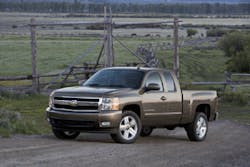In an effort to bolster its reliability image, General Motors has increased its powertrain warranty coverage up to 100,000 miles or five years across its entire 2007 car and light-duty truck lineup in the U.S. and Canada.
After claiming it has closed the quality gap with foreign competitors and achieved a substantial reduction in warranty claims over the last few years, the auto giant “is putting its money where its mouth is,” said GM’s chairman & CEO Rick Wagoner.
“Why are we doing this? It’s simple: It’s something our customers want,” he said during a press conference at GM’s headquarters in Detroit. “We’ve also reduced total warranty repairs 40% over the last five years and the residual value on our cars and light trucks has increased 7 and 3 points, respectively. That shows we’re building higher quality cars and trucks than ever before.”
The no-deductible, fully transferable limited powertrain warranty covers more than 900 components related to the engine, transmission, transfer case (if applicable) and final drive assemblies on all 2007 model-year cars and trucks sold in the U.S. and Canada under GM’s eight brands: Chevrolet, Pontiac, Buick, GMC, Hummer, Saturn, Saab and Cadillac.
The new warranty also applies retroactively to 2007 GM cars and trucks already sold. GM is also expanding its roadside assistance and courtesy transportation programs to match the warranty terms.
For non-powertrain components, GM’s Bumper-to-Bumper New Vehicle Limited Warranty remains in effect: four years or 50,000 miles for Buicks, Cadillacs, Hummers and Saabs, and three years or 36,000 miles for Chevrolets, GMCs, Pontiacs and Saturns
Wagoner noted that the new warranty is the latest result of GM’s ongoing North America turnaround plan, which he believes is starting to pay big dividends. The company turned a profit in the second quarter—the first time it has posted quarterly profits since 2004—while revenues grew to $54 billion.
He added that the company is expecting to slash $9 billion out of its structural costs by the end of 2006. “Our turnaround is still far from complete, but its showing strong results,” Wagoner said. “We’ve even picked up market share and we’re surprising a lot of people.”
To comment on this article, write to Sean Kilcarr at [email protected]
About the Author
Sean Kilcarr
Editor in Chief
Sean Kilcarr is a former longtime FleetOwner senior editor who wrote for the publication from 2000 to 2018. He served as editor-in-chief from 2017 to 2018.
